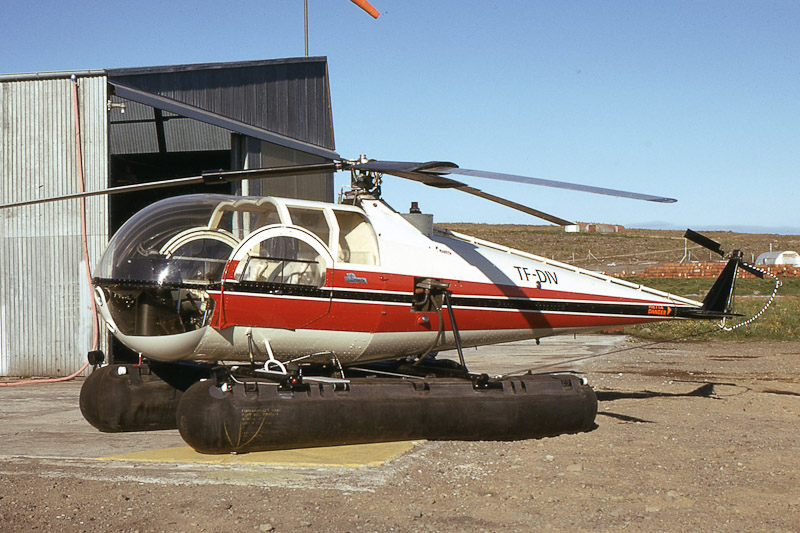|
Aviationweb déjà vu |
helicopters gallery | |
|
Bell 47G | |
|
|
 |
|
| F-GELN | HP824 | |
| Westland-Bell 47G-3 Sioux | ||
 |
 |
|
| AAC XT245 | AAC XT246 | |
| Hiller UH-12 | ||
|
|
 |
|
| Royal Navy XS166 | N212W | |
| Schweizer 269C/300C | ||
 |
 |
|
| N10PY | PH-OTO | |
| MDHI / Hughes 369/500 | ||
|
|
|
|
| D-HMRG | G-CSPJ | |
|
|
 |
|
| LN-OME | PH-HTH | |
| TF-DIV Brantly 305 c/n 1037 - Reykjavik, Iceland - June 1972 | Brantly helicopters | |
|
The 1966-built Brantly 305 s/n 1037 was registered TF-DIV in Iceland with Andre Heioberg, Reykjavik, in December 1966. When Brantly 305 TF-DIV was seen, it had a float instead of wheel landing gear. After registration TF-DIV was cancelled, the Brantly 305 was preserved. The current status of the airframe is unknown. |
||
|
The Brantly 305 is a five-seat light helicopter powered by a single 305 hp Lycoming IVO-540-A1A six-cylinder horizontally-opposed aircooled engine, driving a three-blade main rotor and a two-blade tail rotor. The Brantly 305 is a further development of the Brantly B-2B and of similar configuration, but larger in every respect. Design work of Model 305 began in September 1963 and the prototype (s/n 1000) first flew in January 1964. The enlarged cabin accommodates a total of five persons on two individual side-by-side forward seats with dual controls, and rear bench seat for three persons. The Brantly 305 has doors on each side and a rear compartment for 113 kg baggage, with downward -hinging dooron starboard side. The skid landing gear has four oleo struts, two on each side, and small retracable ground handling wheels. The wheel gear has two main wheels and twin noze wheels. Alternative are skid or float gear. FAA Type certification for Model 305 was approved on 29 July 1965. When FAA Type certification for Model 305, Type Certificate No. H3SW, was issued, Brantly immediately commenced production. British Certificate of Airworthiness was granted in 1966. In 1967, the Brantly 305 lost temporarily its Type Certificat because a number of (fatal) accidents caused by main rotor torsion strap failures. The Type Certification was restored in January 1968, when an Airworthy Directive (AD) was issued requiring immediate replacement of all torsion straps. Next to this, there's a special note in Type Certificate Data Sheet no. H3SW about operating the Brantly 305, the text of this note has to be displayed on a placard in front of and in clear view of the pilot. During its main period of operation from 1965 to 1970, the Brantly 305 was known occasionally to suffer in flight from persistent ground resonance problems. The Brantly 305 was not a commercial success with only 46 built: 41 were built in the mid-1960s; another four were built by Hynes Aviation in 1985 as the H-5; and an improved prototype with redesigned rotor head and new blade aerofoil and a streamlined cabin was built. This prototype completed about 30 hours flying by mid-January 1990. New production was to begin in 1993, but none were built since. Of the 46 Brantly 305 / H-5 helicopters built, at least 16 were w/o in accidents. |
||
|
On 15 December 1953, the Brantly Helicopter Corporation was founded in Philadelphia, Pennsylvania. On 25 April 1966, Lear Jet Corporation announced the acquisition of Brantly Helicopter Corporation through an exchange of stock giving Lear 97% ownership of Brantly. Lear was interested in Brantly with the intention to develop a new, sleek, fast executive jet helicopter. In 1967, Lear Jet Corporation ran into financial problems and was taken over by Gates. Production of the Brantly B-2B and Model 305 continued, but Gates wasn't realy interested in helicopters and in 1969, Gates Lear Jet sold all the rights of Brantly Helicopters to Aeronautical Research & Development Corporation (ARDC) of Cambridge, Massachusetts. Early 1970, ARDC ended production and by the end of 1970, the rights of the Brantly helicopters were acquired by Brantly Operators Inc. of Michael K. Hynes. In 1975, he renamed the company as Brantly-Hynes Helicopter Inc. and later that year, the Franklin Capital Corp, headed by F. Lee Bailey who also owned Enstrom Helicopter Corporation at that time, purchased the company. Brantly-Hynes first was just providing product support but later placed the B-2B and 305 back into production. In 1984, the company was renamed Hynes Helicopter Inc. and in 1987 all assets were offered for sale. In 1989, Brantly Helicopter Industries U.S.A. Co. Ltd. took over manufacturing and marketing rights and production facilities. First new-build B-2B (N25411 c/n 2001) flew 12 April 1991; three (c/n 2001, 2004 and 2006) were built under this name. Production of another four B-2Bs (c/n 2002, 2003, 2005 and 2007) were subsequent manufactured by Brantly International Inc., Vernon, Texas, which received FAA production certificate on 19 July 1996. In 2009, Brantly International and Weifang Tianxiang, Qingdao China, set up a joint venture, Weifang Tianxiang Aerospace Industry Co. Ltd., and received approval to set up a production line in Qingdao. In 2011, the engineering and administrative offices of Brantly were relocated into the facilities of their sister company Superior Air Parts in Coppell, Texas. From this new location Brantly provides communication and technical support for their customers and suppliers. All its manufacturing is done at its parent facility in Qingdao, China, but no new helicopters are currently available for sale. |
||
| page last updated: 19-03-2013 | ||
| Photo Copyright © Jack Poelstra, the Netherlands | ||
|
► aeroplanes index helicopters index EC120 - H120 productionlist Micro Light Aeroplanes European Airfields ◄ |
||
